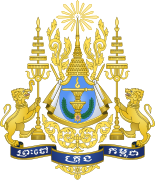Khmer Issarak
Khmer Issarak ខ្មែរឥស្សរៈ | |
|---|---|
 | |
| Dibentuk | 1945 |
| Ideologi | Nasionalisme Khmer Anti-Prancis |
 |
| Artikel ini adalah bagian dari seri Politik dan Ketatanegaraan Kerajaan Kamboja |
| Hubungan luar negeri |
Khmer Issarak (Khmer Merdeka, atau Khmer Independent) (Bahasa Khmer: ខ្មែរឥស្សរៈ) adalah sebuah gerakan independen anti-kolonial dan anti-Prancis "kurang terstruktur".[1] Disamping itu, gerakan tersebut dilabeli sebagai “tak berbentuk”.[2] Issarak terbentuk sekitar 1945 dan terdiri dari beberapa faksi masing-masing denagn pemimpinnya sendiri.[3] Kebanyakan kelompok Issarak aktif berjuang antara 1945, pada akhir Perang Dunia Kedua sampai 1953, saat Kamboja merdeka. Tujuan-tujuan awal Khmer Issarak adalah untuk bertarung melawan Prancis dalam rangka meraih kemerdekaan. Kemudian, pelengseran pemerintah Kamboja menjadi agenda beberapa kelompok Issarak.[1] [4] Lebih lanjut, istilah Issarak awalnya merujuk kepada non-komunis, namun pada awal 1950an, kelompok gerilyawan yang dipandu Việt Minh menyebut diri mereka sendiri Issarak untuk mengguncang persatuan pasukan non-komunis lainnya.[4]
Issarak[sunting | sunting sumber]
Sebagai hasil dari Konferensi Jenewa pada tahun 1954, sebagian besar warga Vietnam yang dipandu oleh Issarak diasingkan ke Republik Demokratik Vietnam (DRV) atau berbelok ke bawah tanah dan membentuk organisasi-organisasi komunis.[5] Pada saat yang sama, karena Kamboja telah memperoleh kemerdekaan dari Prancis, sebagian besar nasionalis Issaraks dan beberapa kelompok komunis melucuti persenjataan dari diri mereka sendiri.[6] Beberapa pemimpin Issarak ternama seperti Dap Chhuon dan Pangeran Norodom Chantaraingsey bersekutu dengan pemerintah Sihanouk dalam periode waktu yang berbeda. Gerakan Khmer Issarak akhirnya memudar.
Catatan[sunting | sunting sumber]
- ^ a b Murashima, Eiji (November 1, 2005). "Opposing French colonialism Thailand and the independence movements in Indo-China in the early 1940s". South East Asia Research. 13 (3): 333–383. doi:10.5367/000000005775179702.
- ^ Becker 1998, hlm. 51.
- ^ Grant, Edited by Jonathan S.; Moss,, Laurence A. G.; Unger, Jonathan (1971). Cambodia: the widening war in Indochina. New York: Washington Square Press. hlm. 314. ISBN 0671481142.
- ^ a b Becker 1998, hlm. 70.
- ^ Becker 1998, hlm. 78.
- ^ Becker 1998, hlm. 76.
Sumber[sunting | sunting sumber]
- Becker, E. (1998). When the war was over: Cambodia and the Khmer rouge revolution. New York: Public Affairs.
- Chandler, D. P. (1991). The tragedy of Cambodian history: Politics, war, and revolution since 1945. New Haven: Yale University Press.
- Chandler, D. P. (2008). A history of Cambodia. Boulder, Colo: Westview Press.
- Dommen, A. J. (2001). The Indochinese experience of the French and the Americans: Nationalism and communism in Cambodia, Laos, and Vietnam. Bloomington: Indiana University Press.
- Grant, J. S., Moss, L. A. G., & Unger, J. (1971). Cambodia; the widening war in Indochina. New York: Washington Square Press.
- Kiernan, B. (2004). How pol pot came to power. New Haven, Conn; London: Yale University Press.
- McHale, S. (2013). Ethnicity, violence, and Khmer-Vietnamese relations: The significance of the lower Mekong delta, 1757–1954. The Journal of Asian Studies, 72(2). doi:10.1017/S0021911813000016
- Murashima, E. (2005). Opposing French colonialism Thailand and the independence movements in Indo-china in the early 1940s. South East Asia Research, 13(3), 333-383. doi:10.5367/000000005775179702
- Tully, J. A. (2002). France on the Mekong: A history of the protectorate in Cambodia, 1863-1953. Lanham, MD: University Press of America.
- Vickery, M. (1984). Cambodia 1975-1982. Hemel Hempstead; North Sydney: Allen and Unwin in association with South End.
Bacaan tambahan[sunting | sunting sumber]
- Chandler, D. (1997). From `Cambodge' to `Kampuchea': State and revolution in Cambodia 1863-1979. Thesis Eleven, 50(1), 35-49. doi:10.1177/0725513697050000004
- Chandler, D. P. (2000). A history of Cambodia. Boulder, Colo: Westview Press.
- Cambodia: Kampuchea. Gerrand, J., Littlemore, S., Jane Balfour Films Ltd and James Gerrand & investors (Directors). (1988).[Video/DVD] London: Jane Balfour Films Ltd.
- Eanes, J. (2002). The rise and fall of the khmer rouge. ProQuest, UMI Dissertations Publishing).
- Fretter, J., & Bercovitch, J. (2004). France-indochina: Independence struggle December 1945-July 1954. Washington, DC: CQ Press.
- Jackson, K. D. (1989). Cambodia, 1975-1978: Rendezvous with death. Princeton, N.J: Princeton University Press.
- Keyes, C. (1990). Buddhism and revolution in Cambodia. Cambridge: Cultural Survival, Inc.
- Kiernan, B., & Boua, C. (1982). Peasants and politics in kampuchea, 1942-1981. Armonk, N.Y; London: Zed Press.
- Kissi, E. (2006). Revolutions and genocides in Ethiopia and Cambodia. Lanham, MD: Lexington Books.
- Nguyen-Vo, T. (1992). Khmer-viet relations and the third indochina conflict. Jefferson, N.C: McFarland.
- Peou, S. (2001). Cambodia: Change and continuity in contemporary politics. Aldershot, Hants; Burlington, Vt: Ashgate.
- Shinde, B. E. (1982). Outline history of kampuchean communism 1930-78. China Report, 18(1), 11-47. doi:10.1177/000944558201800102
- Thion, S. (1993). Watching Cambodia: Ten paths to enter the Cambodian tangle. Bangkok: Cheney.
